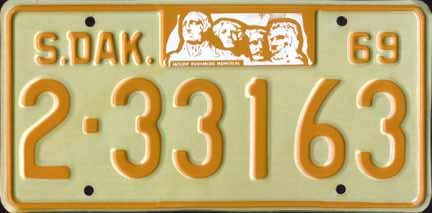
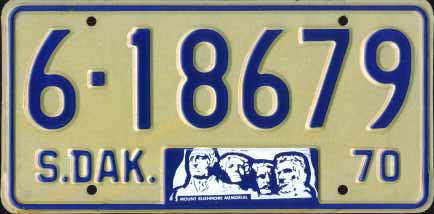
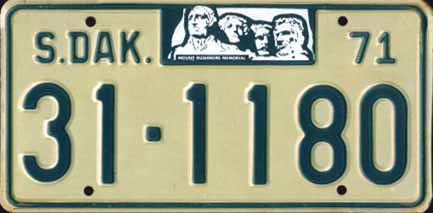
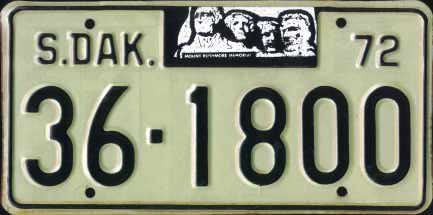
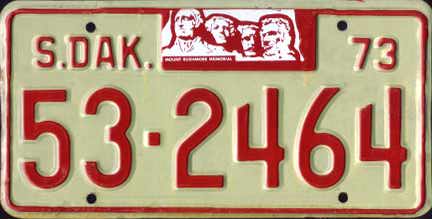
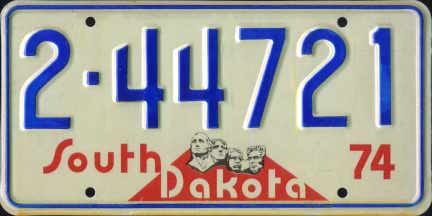
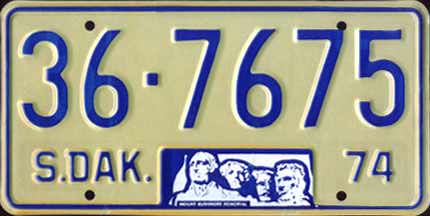
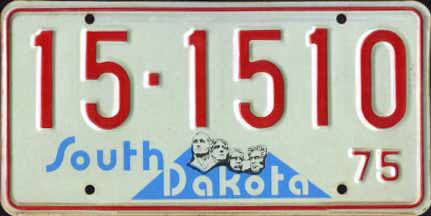


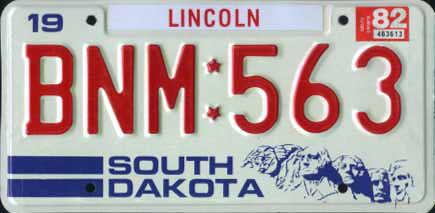
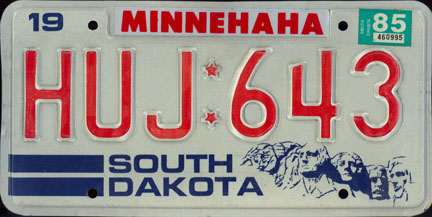
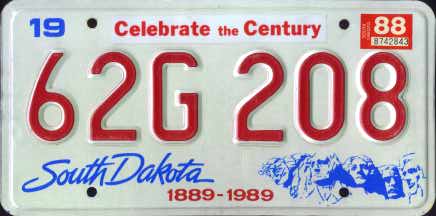
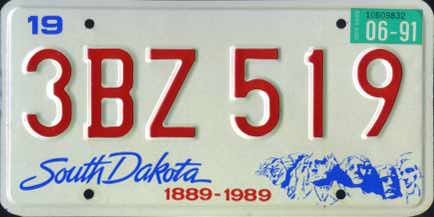
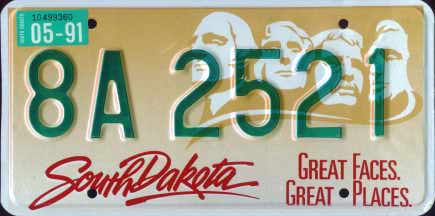
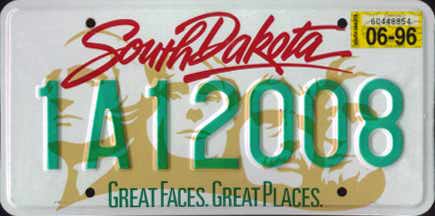
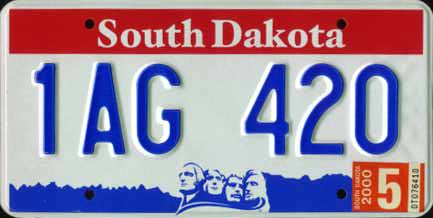
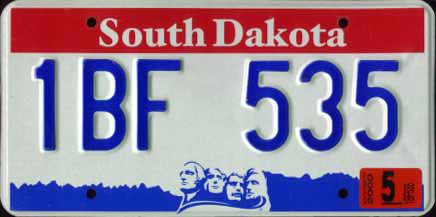
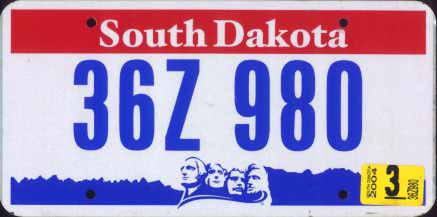
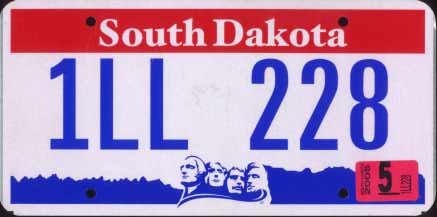
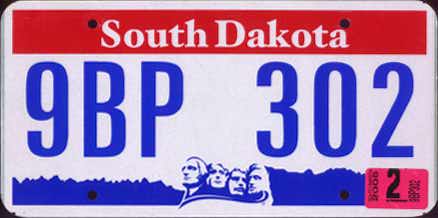
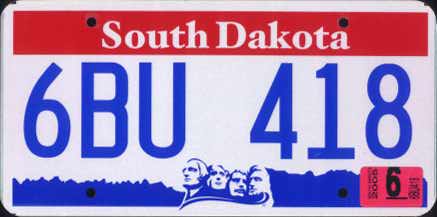

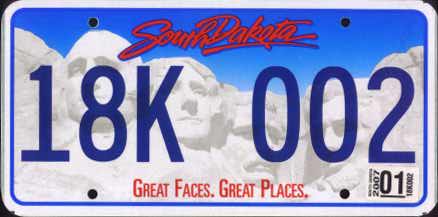
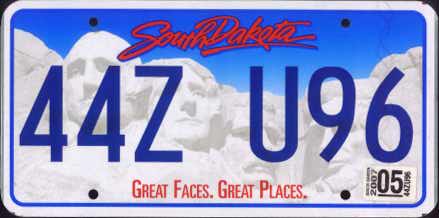
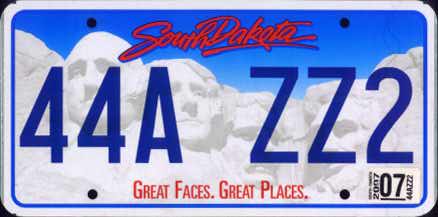

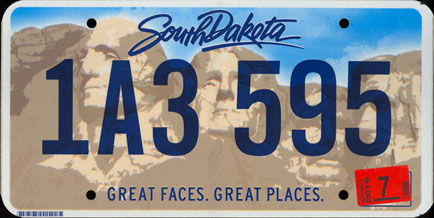
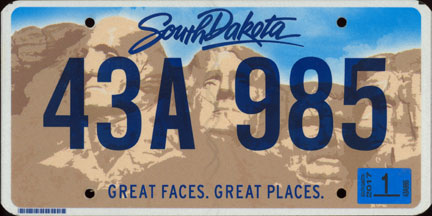
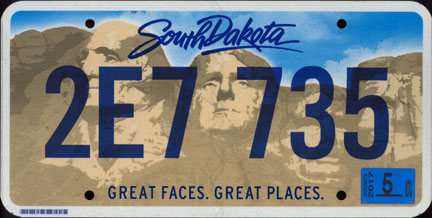
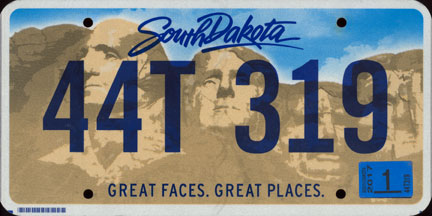
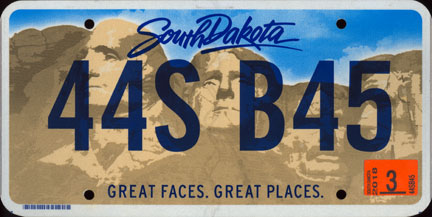
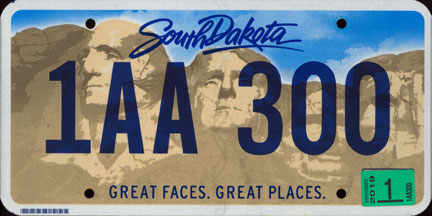
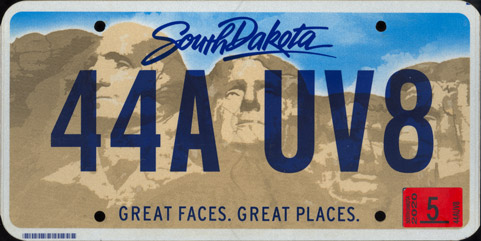
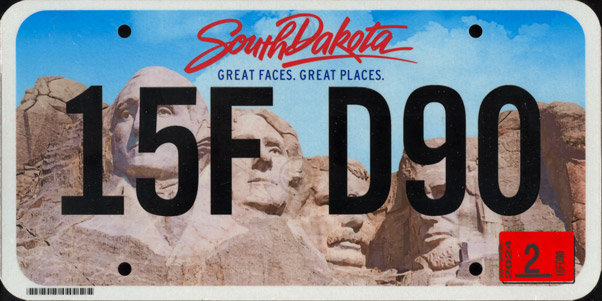

 |
South Dakota 1969 Passenger issue. South Dakota plates have featured a drawing of Mount Rushmore in some form from 1952 through the present. During this era, the drawing was stamped into a rectangular box between the state name and year on the plate using white paint. Plates of this era were coded with a numeric county code, with the first nine numbers issued to the largest counties in order of population, alphabetically thereafter. Plates were all numeric, with the first one or two numbers (before the dash) indicating the county code and the rest being serial. This plate was issued in Pennington county, #2. Click here for a complete listing of South Dakota county codes. |
 |
South Dakota 1970 Passenger issue. This plate was issued in county #6, Brookings county. The Rushmore drawing is moved to the bottom this year, as was done periodically. |
 |
South Dakota 1971 Passenger issue. Same format as above, this plate was issued in a lower-population county with a two-digit county code. Code #31 indicates Haakon county. |
 |
South Dakota 1972 Passenger issue. Another two-digit county, this one comes from Hughes county, where the capitol of South Dakota, Pierre, is located. |
 |
South Dakota 1973 Passenger issue. This plate was issued in county #53, Perkins county. |
 |
South Dakota 1974 Passenger issue. This plate was the first screened graphic issue for South Dakota, and in fact the first in U.S. history. This plate won the 1974 ALPCA Plate of the Year award, and opened the floodgates for the multitude of screened graphic issues that followed throughout the U.S. and elsewhere. This plate was again issued in Pennington county, #2. |
 |
South Dakota 1974 Passenger issue. Not all 1974 South Dakota plates were as trend-setting as the one above. A few plates were stamped on the old-style embossed base. These were apparently localized in county #5 (Codington) and also seen on some overrun plates for other counties, such as this one from #36 (Hughes). |
 |
South Dakota 1975 Passenger issue. By 1975, apparently all counties had agreed on the screened baseplate, and this plate was issued to all motorists. The stamped "75" may be a concession to the older base, however. This was the last yearly issue for South Dakota, and also marked the end of the numeric county codes for a short while (they were re-established in 1987). This plate came from county #15, Butte county. |
 |
South Dakota 1975 Passenger issue. This was something of an odd issue - the state established these 'A' prefix plates for residents of the ten largest cities in the state as far back as 1939 as a way of establishing parking privleges within the cities. This practice was discontinued after the 40s, except for Minnehaha county (#1), which continued to use the A1 prefix through 1975. From 1945 on, however, the prefix's usage was reversed, with the A1 plates issued to county residents outside the Sioux Falls area, and all-numeric #1 plates issued within greater Sioux Falls. |
 |
South Dakota 1978 Passenger issue. This red, white and blue baseplate was first issued in 1976 to celebrate the Bicentennial. This plate has always been one of my favorites, and was an inspiration to start collecting back in my youth. During this period, county code numbers were replaced by code letters, with "FR" being a Fall River county issue. The separator was changed from a dash to a pair of stars, one right side up and the other upside down. This baseplate was used through the end of 1980. |
 |
South Dakota 1982 Passenger issue. This new baseplate was issued at the end of 1980, and again features Mount Rushmore at the bottom. The serial was changed to a straight ABC-123 format with no embossed county codes, and a county sticker was used at the top to identify the county of issue. The star separators were once again used on this baseplate. This plate was used with stickers through the end of 1986. It was the ALPCA Plate of the Year in 1981. |
 |
South Dakota 1985 Passenger issue. Continuation of the above base, later plates changed to a serial format using only vowels in the center position and only consonants in the first and last positions. This allowed serials to move and change more quickly. This helped mitigate a common issue with smaller states using an ABC-123 arrangement where pretty much every plate ends up starting with A or B, making partial identifications essentially useless. |
 |
South Dakota 1988 Passenger issue. This baseplate was issued at the end of 1986, and commemorated the state's centennial in 1989. The county code numbers were re-established as of this baseplate, with two-digit counties issued plates in a 12A 345 format, and one-digit counties in a 1AB 234 format. This plate was issued in county #62, Union county. Some issues on this base were given a sticker with the slogan "Celebrate the Century" to place along the top edge. This plate was used through the end of 1991. |
 |
South Dakota 1991 Passenger issue. Continuation of the above baseplate, this plate was issued in county #3, Brown county, and features the 1AB 234 serial format. This plate also does not have the "Celebrate the Century" sticker at the top. Staggered registrations were established in 1991, so this plate has a month and year sticker, although the "19" portion of the year remains screened in the top left corner. |
 |
South Dakota 1991 Passenger issue. This plate was phased in from 1990 through 1991 and features a larger picture of Mount Rushmore in the background. The slogan "Great Faces. Great Places." was also introduced. This plate was issued in a 1A 2345 format (one-digit counties) and a 12 A345 format (two-digit counties). This baseplate was used through the end of 1995. This particular plate was a Davison county (#8) issue. |
 |
South Dakota 1996 Passenger issue. This baseplate was introduced in 1995 and immediately caused problems due to poor visibility at a distance. The slogan and graphic remain from the 1990 base, but the new design makes the serial very hard to read. This plate was rumored to have been slated for early replacement, but it was used for a full five-year period and was replaced as of 2000. This issue came from county #1, Minnehaha county, the largest in the state. |
 |
South Dakota 2000 Passenger issue. South Dakota went through another general changeover in 2000, replacing all the previous bases with this baseplate. This easy-to-read red, white and blue baseplate was chosen to avoid the kinds of visibility problems the state had with the previous plates. The Mount Rushmore graphic was retained at the bottom center of the plate, this time in a stylized version with a Copyright symbol below the graphic. The serial format was also changed back to 1AB 234, the same format used on the 1989 Centennial base. Standard county coding was once again used on these plates, with this one being issued again in Minnehaha county (#1). Some early issued of this plate received old-style 2000 stickers like the ones that had been issued on the previous base. |
 |
South Dakota 2000 Passenger issue. Continuation of the above baseplate, this one features the re-designed, smaller computer printed sticker. These new stickers have the plate number printed on them to avoid fraudulent use. |
 |
South Dakota 2004 Passenger issue. Hey, great, more flat plates. South Dakota started producing their standard passenger issues as flat plates in late 2003. These were somewhat odd, however, as the plates were still made of steel, which is something I haven't seen with these flats before. These may be a bit less susceptible to bending, although they do still flap around quite a bit. The steel material was temporary until older blanks were used up. This plate was issued in Hughes county (#36), which was apparently about to run out of available numbers in the 36A 123 format at the time (19 to go after this one). |
 |
South Dakota 2005 Passenger issue. Shortly after the introduction of the flat version of this plate, the minor font changes started coming. This plate is the second version of the flat plate, using a slightly different version of the small 3M font, with a narrower stroke than the previous version. Compare the "8" on this plate to the one above for the best example. Most plates using this font were made on aluminum, however the change in materials seems to have come in right around this time so there are some examples of this font in steel as well. If you're into that sort of thing. |
 |
South Dakota 2005 Passenger issue. Another revised version of the flat plate, this issue uses the larger, fatter version of the ugly 3M generic serial font, as opposed to the smaller versions used on initial flat South Dakota plates. This plate is also made of aluminum, lending some credence to my theory that their flat steel plates were temporary until the steel blanks were used up. This example comes from Lawrence county, #9. |
 |
South Dakota 2005 Passenger issue. Yet another revision on the flat plate, this one uses a custom font for the serial which is actually pretty nice looking. I've said all along that these flat plates wouldn't be half so bad if it wasn't for the generic fonts that they all seem to use, so it's nice to see a couple states moving towards distinctive serial fonts on their flat plates. Still don't like 'em, mind you, but it's a step in the right direction. |
 |
South Dakota 2007 Passenger issue. This new plate was released in January, 2006 and slated to replace all previous plates by the end of the year. The new plate reintroduces the full graphic of Mt. Rushmore in the background, while also re-using the "Great Faces. Great Places." slogan from the '90s. For the first time with this issue, South Dakota kept the numbering format going from where the previous base left off. This plate was an early issue from Minnehaha county (#1), which seems to have started this new base in the NA series. |
 |
South Dakota 2007 Passenger issue. Two-digit county version of this plate using a single-alpha format. This plate was issued in Clark county. |
 |
South Dakota 2007 Passenger issue. Two-digit counties that surpassed their initial allocation of plates in the single-alpha series once again extended the series using this 12A-B34 format on this base. There were a handful of counties that were already using the two-alpha system on the old base and continued the series on the new one. A number of medium-population counties were also pushed into this system as a result of the series picking up where the last one left off, so far more two-digit counties are seen with two-alpha prefixes on this base than on the last. This plate came from Lincoln county, the largest of the two-digit counties. |
 |
South Dakota 2007 Passenger issue. Lincoln county started on this new base somewhere around the beginning of the 44S-A## series, and as a result ran short of available two-alpha serials before the end of the 2006 reissue. This new three-alpha format was then introduced, starting at 44A-AA1, to accommodate the overflow. Not sure I would've issued this particular phonetically-pleasing series, myself. |
 |
South Dakota 2011 Passenger issue. In 2010, Minnehaha County became the first and only single-digit county to overrun its allocation of numbers and flip to a three-letter format. |
 |
South Dakota 2016 Passenger issue. A new issue was introduced in South Dakota in late 2015, featuring another reshuffling of familiar elements including a new full Mount Rushmore graphic and the "Great Faces. Great Places." slogan. This graphic has been criticized for apparent liberties taken with the mountain image, the monument is depicted from an odd angle compared to previous versions. The state put 3M through their paces once again, requesting another unique serial font. These plates are issued in a 1A2 345 format in one-digit counties and 12A 345 in two-digit, same as the 1990 base with different spacing. These plates are from from Minnehaha county and Lake county, #1 and #43 respectively. |
 |
|
 |
South Dakota 2017 Passenger issue. Continuation of the base above, the graphic was tweaked slightly fairly early on in this plate's issue to add more detail to the Mt. Rushmore graphic. This new design adds more texture, especially to the left and bottom of the graphic. These plate were issued in counties #2 and #44, Pennington and Lincoln. |
 |
|
 |
South Dakota 2018 Passenger issue. As usual, certain South Dakota counties began overrunning their initial allocations as of 2017, including habitual offender Lincoln county, #44. Two-digit counties running past plate number ##Z-999 flip to this 12A B34 format instead. Lincoln got a fair way into a three-letter arrangement on the previous base and will likely do so on this one as well. |
 |
South Dakota 2019 Passenger issue. Minnehaha county also overran its allocation of 1A2 345 format plates in 2018 and added a second letter to extend the series. |
 |
South Dakota 2020 Passenger issue. Lincoln county ran through its two-letter allocation as well by 2019 and went to a third, in a 44A BC1 configuration. |
 |
South Dakota 2024 Passenger issue. South Dakota began a general reissue in 2023 to this new, hilariously illegible design. This light edit of the previous base changes the background to a photorealistic depiction of Mt. Rushmore which renders the first and last characters of the now-black serial unreadable, and also changes the state name to red with the slogan moved to the top of the plate. Serials appear to have resumed where the last base left off, which will likely result in even smaller counties issuing plates in the two- and three- letter formats on this base. |
| Ahead to Tennessee | |
| Back to South Carolina |
Return to U.S. Plates Index
Last Modified 7/8/2023 (added 2020 and 2024 plates).